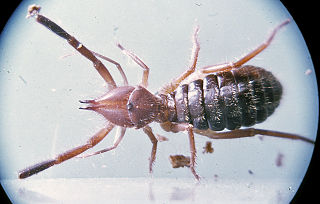
Solifugae is an order of animals in the class Arachnida known variously as camel spiders, wind scorpions, sun spiders, or solifuges. The order includes more than 1,000 described species in about 147 genera. Despite the common names, they are neither true scorpions, nor true spiders. Most species of Solifugae live in dry climates and feed opportunistically on ground-dwelling arthropods and other small animals. The largest species grow to a length of 12–15 cm (5–6 in), including legs. A number of urban legends exaggerate the size and speed of the Solifugae, and their potential danger to humans, which is negligible.

John Laird Mair Lawrence, 1st Baron Lawrence,, known as Sir John Lawrence, Bt., between 1858 and 1869, was an English-born Ulsterman who became a prominent British Imperial statesman and served as the Viceroy of India from 1864 to 1869.

Major General Euston Henry Sartorius was a recipient of the Victoria Cross (VC), the highest and most prestigious award for gallantry in the face of the enemy that can be awarded to British and Commonwealth forces. His brother Reginald was also awarded the VC.

The Lyell Medal is a prestigious annual scientific medal given by the Geological Society of London, equal in status to the Murchison Medal. This medal is awarded based on one Earth Scientist's exceptional contribution of research to the scientific community. It is named after Charles Lyell.
Sir Reginald Frederick Brittain Bennett was an English Conservative Party politician, international yachtsman, psychiatrist and painter.

Galeodes is a genus of solifuges or sun spiders. The nearly 200 species in this genus are found in northern Africa, southeastern Europe and Asia. Like other solifuges, they are mainly nocturnal and found in arid habitats. They often have long hairy appendages and are not as stout bodied or dark and contrastingly coloured as some other solifuges. Some Galeodes species are able to produce sounds by stridulation. These are usually raspy or hiss-like and may be imitations of the sounds of vipers, to serve a defensive function. As in other solifuges, mating involves the male depositing a spermatogonia that is manipulated into the female genital opening using their chelicera. The male strokes the female using the palps allowing her to be approached. Females will often feed on males before or after mating. The female then deposits the eggs in a burrow in soil and in some species guards them.

Daesiidae is a family of solifugids, which are widespread in Africa and the Middle East. Members of the family are also present in India, Italy, South America, the Balkans, and the single species Gluvia dorsalis in the Iberian Peninsula. A single fossil species is known from Eocene Baltic amber.
Megaschizomus is a genus of hubbardiid short-tailed whipscorpions, first described by Reginald Frederick Lawrence in 1969.

Rhagodidae is a family of solifuges, first described by Reginald Innes Pocock in 1897.
The following is the list of squads that took place in the men's field hockey tournament at the 1956 Summer Olympics.

Hexisopodidae is a family of solifuges, first described by Reginald Innes Pocock in 1897.
Pseudocleobis is a genus of ammotrechid camel spiders, first described by Reginald Innes Pocock in 1900.
Mumaella is a monotypic genus of daesiid camel spiders, first described by Mark Harvey in 2002. Its single species, Mumaellarobusta is distributed in Afghanistan.
Namibesia is a monotypic genus of daesiid camel spiders, first described by Reginald Frederick Lawrence in 1962. Its single species, Namibesiapallida is distributed in Namibia.
Gylippidae is a family of solifuges, first described by Carl Friedrich Roewer in 1933.
Trichotoma is a genus of gylippid camel spiders, first described by Reginald Frederick Lawrence in 1968.
Melanoblossia is a genus of melanoblossiid camel spiders, first described by William Frederick Purcell in 1903.
Rhagodes is a genus of rhagodid camel spiders, first described by Reginald Innes Pocock in 1897.
Gylippus is a genus of gylippid camel spiders, first described by Eugène Simon in 1879.
Zeriassa is a genus of solpugid camel spiders, first described by Reginald Innes Pocock in 1897.







